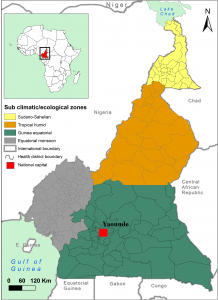
KRACALIK, MORRIS, BLACKBURN – Cholera in Cameroon, 2000-2012: Spatial and Temporal Analysis at the Operational (Health District) and Sub Climate Levels
Moise C. Ngwa, Song Liang, Ian T. Kracalik, Lillian Morris, Jason K. Blackburn, Leonard M. Mbam, Simon Franky Baonga Ba Pouth, Andrew Teboh, Yang Yang, Mouhaman Arabi, Jonathan D. Sugimoto, John Glenn Morris Jr.
Article first published online: 17 NOV 2016 PLoS Neglected Tropical Diseases
DOI: 10.1371/journal.pntd.0005105
ABSTRACT:
Cholera was first reported in Cameroon in 1971. From 2000–2012, Cameroon reported on average 3,344.2 cases per year. When we divided the country into its four climate subzones (Sudano-Sahelian, Tropical Humid, Guinea Equatorial, and Equatorial Monsoon), there were very different patterns of spatial clustering of health districts with elevated attack rates, as well as differing sets of ecological determinants of cases counts. In the northern Sudano-Sahelian climate subzone, reported cases tended to occur between July and September, during the rainy season; whereas, the southern Equatorial Monsoon subzone reported cases year-round, with the lowest burden during the same rainy season. As cholera displays different epidemiological patterns by subzone, a single approach to controlling cholera for the whole nation does not appear to be viable. Additional prospective epidemiological studies are needed to further elucidate subzone-specific determinants of cholera burden, in order to provide sufficient evidence-based guidance for the formulation and assessment of regionally tailored intervention strategies.
Read the full publication at PLoS Neglected Tropical Diseases